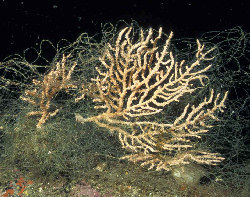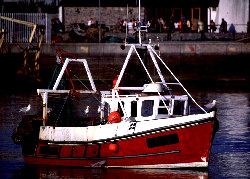

Effects of Fishing within European Marine Sites
This Web site updates the 'information' component of decision-making in relation to fisheries activities within Natura 2000 protected sites. The habitats and species listed in the Habitats Directive (1992) are used to structure the report but any habitats likely to occur within the (sometimes broad) habitat definitions of the Habitats Directive are included. The Birds Directive (1979) does not specifically identify habitats in the same way as the Habitats Directive but a large number of species are listed. This report therefore addresses fishing impacts on two groupings of birds: sea birds and wildfowl and waders.
Since 1999, numerous scientific reports and reviews have been published that describe the impacts of fisheries on marine habitats and species. Notably, several fishery impact bibliographies have also been produced since 1999 and these have been referred to during this review.
The report is based on Gubbay & Knapman (1999). It repeats some of that information but includes additional descriptive and illustrative material. A further 95 articles have been reviewed and added to the 96 identified and tabulated in the 1999 report. The full set of references is now held in a database designed to provide the 'back-end' of this Web site.
Over Fifty different types of fishing are catalogued in the database. Mariculture is also included. Separate descriptions are given of fisheries impacts on Annex I habitats and on Annex II species from the Habitats Directive and more general accounts for species listed in Annex IV of the Habitats Directive and birds from the Birds Directive. The reviewed papers indicate that, if located responsibly and appropriately managed, there are a number of fishing activities, which can have a minimal impact on species and habitats of marine natural heritage importance. In particular, static gears such as pots or creels and hand gathering are likely to have a minimal impact when compared to the use of mobile fishing gears. In many cases, static and mobile fishing methods are used to target the same species. For most types of fishing, recovery from damaging impacts is likely to be within less than a year or in a few years if fishing impact is infrequent. However, even where recovery occurs rapidly, the type of community present may change especially through loss of epibenthic and long-lived and slow growing species. An increase in scavenging and opportunistic species is also common in areas recently fished with some types of mobile gear.
Generally, more dynamic habitats that are subjected to regular, natural disturbance are able to recover more quickly from the effects of fishing. Although even these habitats may contain slow growing, long-lived species, which are unable to recover quickly from the physical damage caused by some fishing methods. It is on biogenic reefs and hard substratum where long-term damage to species and communities is most likely to occur. Aquaculture can have minimal impact if sensitively sited although substratum below aquaculture cages is likely to be changed and aquaculture is often responsible for the import and spread of non-native species.
Most of the studies reviewed have been undertaken in areas that have few sensitive species. Indeed, if sensitive species were once present, they may have been destroyed by bottom gear before the areas were subject to research. Some more recent studies have addressed actual or potential impacts on fragile habitats and species that are unlikely to recover rapidly if at all. There are still significant gaps in our knowledge about impacts on a number of potentially sensitive habitats and species including those in sea lochs where habitats may not be protected by the Habitats Directive, hindering research into fishing practices that damage sensitive fauna and flora.
As more-and-more decisions about environmental protection use 'the ecosystem approach' it has been important to note some consequential effects of fishing on prey availability, nutrient cycling, substratum modification, collateral damage to wildlife interests etc.
References
Sewell, J., Harris, R., Hinz, H., Votier, S. and Hiscock, K. 2007. An Assessment of the Impact of Selected Fishing Activities on European Marine Sites and a Review of Mitigation Measures. Report to the Seafish Industry Authority (Seafish). Marine Biological Association of the UK, Plymouth and the University of Plymouth, members of the Plymouth Marine Sciences Partnership (PMSP).
Sewell, J. & Hiscock, K., 2005. Effects of fishing within UK European Marine Sites: guidance for nature conservation agencies. Report to the Countryside Council for Wales, English Nature and Scottish Natural Heritage from the Marine Biological Association. Plymouth: Marine Biological Association. CCW Contract FC 73-03-214A.
Gubbay. S. & Knapman, P.A. 1999. A review of the effects of fishing within UK European marine sites. Peterborough: English Nature (UK Marine SACs Project). 134 pages.
Images © Keith Hiscock and Harvey Tyler-Walters.




